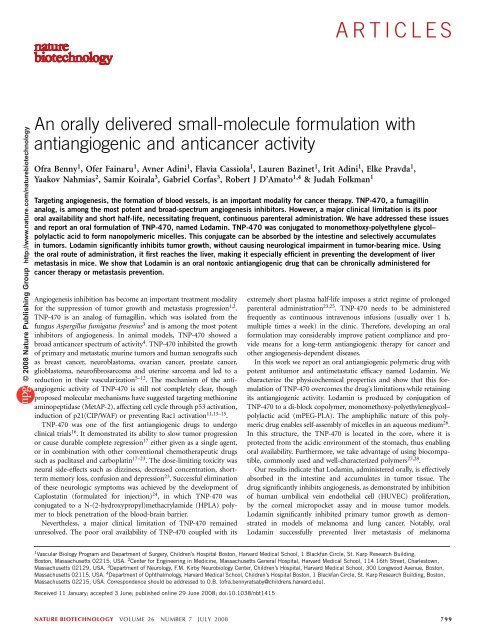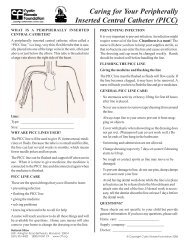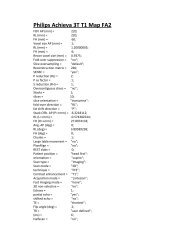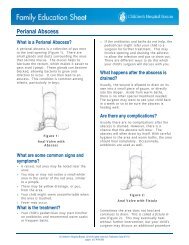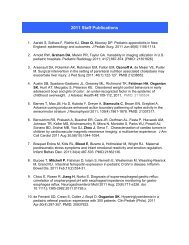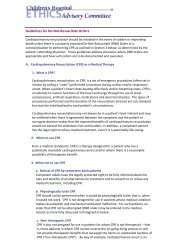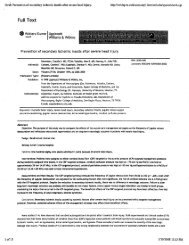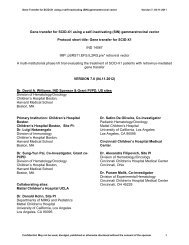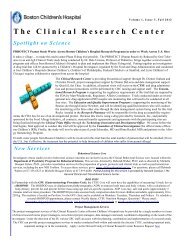PDF version - Children's Hospital Boston
PDF version - Children's Hospital Boston
PDF version - Children's Hospital Boston
Create successful ePaper yourself
Turn your PDF publications into a flip-book with our unique Google optimized e-Paper software.
© 2008 Nature Publishing Group http://www.nature.com/naturebiotechnology<br />
An orally delivered small-molecule formulation with<br />
antiangiogenic and anticancer activity<br />
Ofra Benny 1 , Ofer Fainaru 1 , Avner Adini 1 , Flavia Cassiola 1 , Lauren Bazinet 1 , Irit Adini 1 , Elke Pravda 1 ,<br />
Yaakov Nahmias 2 , Samir Koirala 3 , Gabriel Corfas 3 , Robert J D’Amato 1,4 & Judah Folkman 1<br />
Targeting angiogenesis, the formation of blood vessels, is an important modality for cancer therapy. TNP-470, a fumagillin<br />
analog, is among the most potent and broad-spectrum angiogenesis inhibitors. However, a major clinical limitation is its poor<br />
oral availability and short half-life, necessitating frequent, continuous parenteral administration. We have addressed these issues<br />
and report an oral formulation of TNP-470, named Lodamin. TNP-470 was conjugated to monomethoxy-polyethylene glycol–<br />
polylactic acid to form nanopolymeric micelles. This conjugate can be absorbed by the intestine and selectively accumulates<br />
in tumors. Lodamin significantly inhibits tumor growth, without causing neurological impairment in tumor-bearing mice. Using<br />
the oral route of administration, it first reaches the liver, making it especially efficient in preventing the development of liver<br />
metastasis in mice. We show that Lodamin is an oral nontoxic antiangiogenic drug that can be chronically administered for<br />
cancer therapy or metastasis prevention.<br />
Angiogenesis inhibition has become an important treatment modality<br />
for the suppression of tumor growth and metastasis progression 1,2 .<br />
TNP-470 is an analog of fumagillin, which was isolated from the<br />
fungus Aspergillus fumigatus fresenius 3 and is among the most potent<br />
inhibitors of angiogenesis. In animal models, TNP-470 showed a<br />
broad anticancer spectrum of activity 4 . TNP-470 inhibited the growth<br />
of primary and metastatic murine tumors and human xenografts such<br />
as breast cancer, neuroblastoma, ovarian cancer, prostate cancer,<br />
glioblastoma, neurofibrosarcoma and uterine sarcoma and led to a<br />
reduction in their vascularization 5–12 . The mechanism of the antiangiogenic<br />
activity of TNP-470 is still not completely clear, though<br />
proposed molecular mechanisms have suggested targeting methionine<br />
aminopeptidase (MetAP-2), affecting cell cycle through p53 activation,<br />
induction of p21(CIP/WAF) or preventing Rac1 activation 11,13–15 .<br />
TNP-470 was one of the first antiangiogenic drugs to undergo<br />
clinical trials 16 . It demonstrated its ability to slow tumor progression<br />
or cause durable complete regression 17 either given as a single agent,<br />
or in combination with other conventional chemotherapeutic drugs<br />
such as paclitaxel and carboplatin 17–23 .Thedose-limitingtoxicitywas<br />
neural side-effects such as dizziness, decreased concentration, shortterm<br />
memory loss, confusion and depression 23 . Successful elimination<br />
of these neurologic symptoms was achieved by the development of<br />
Caplostatin (formulated for injection) 24 , in which TNP-470 was<br />
conjugated to a N-(2-hydroxypropyl)methacrylamide (HPLA) polymer<br />
to block penetration of the blood-brain barrier.<br />
Nevertheless, a major clinical limitation of TNP-470 remained<br />
unresolved. The poor oral availability of TNP-470 coupled with its<br />
Received 11 January; accepted 3 June; published online 29 June 2008; doi:10.1038/nbt1415<br />
ARTICLES<br />
extremely short plasma half-life imposes a strict regime of prolonged<br />
parenteral administration 23,25 . TNP-470 needs to be administered<br />
frequently as continuous intravenous infusions (usually over 1 h,<br />
multiple times a week) in the clinic. Therefore, developing an oral<br />
formulation may considerably improve patient compliance and provide<br />
means for a long-term antiangiogenic therapy for cancer and<br />
other angiogenesis-dependent diseases.<br />
In this work we report an oral antiangiogenic polymeric drug with<br />
potent antitumor and antimetastatic efficacy named Lodamin. We<br />
characterize the physicochemical properties and show that this formulation<br />
of TNP-470 overcomes the drug’s limitations while retaining<br />
its antiangiogenic activity. Lodamin is produced by conjugation of<br />
TNP-470 to a di-block copolymer, monomethoxy-polyethyleneglycol–<br />
polylactic acid (mPEG-PLA). The amphiphilic nature of this polymeric<br />
drug enables self-assembly of micelles in an aqueous medium 26 .<br />
In this structure, the TNP-470 is located in the core, where it is<br />
protected from the acidic environment of the stomach, thus enabling<br />
oral availability. Furthermore, we take advantage of using biocompatible,<br />
commonly used and well-characterized polymers 27,28 .<br />
Our results indicate that Lodamin, administered orally, is effectively<br />
absorbed in the intestine and accumulates in tumor tissue. The<br />
drug significantly inhibits angiogenesis, as demonstrated by inhibition<br />
of human umbilical vein endothelial cell (HUVEC) proliferation,<br />
by the corneal micropocket assay and in mouse tumor models.<br />
Lodamin significantly inhibited primary tumor growth as demonstrated<br />
in models of melanoma and lung cancer. Notably, oral<br />
Lodamin successfully prevented liver metastasis of melanoma<br />
1 Vascular Biology Program and Department of Surgery, Children’s <strong>Hospital</strong> <strong>Boston</strong>, Harvard Medical School, 1 Blackfan Circle, St. Karp Research Building,<br />
<strong>Boston</strong>, Massachusetts 02215, USA. 2 Center for Engineering in Medicine, Massachusetts General <strong>Hospital</strong>, Harvard Medical School, 114 16th Street, Charlestown,<br />
Massachusetts 02129, USA. 3 Department of Neurology, F.M. Kirby Neurobiology Center, Children’s <strong>Hospital</strong>, Harvard Medical School, 300 Longwood Avenue, <strong>Boston</strong>,<br />
Massachusetts 02115, USA. 4 Department of Ophthalmology, Harvard Medical School, Children’s <strong>Hospital</strong> <strong>Boston</strong>, 1 Blackfan Circle, St. Karp Research Building, <strong>Boston</strong>,<br />
Massachusetts 02215, USA. Correspondence should be addressed to O.B. (ofra.bennyratsaby@childrens.harvard.edu).<br />
NATURE BIOTECHNOLOGY VOLUME 26 NUMBER 7 JULY 2008 799
© 2008 Nature Publishing Group http://www.nature.com/naturebiotechnology<br />
ARTICLES<br />
a<br />
b<br />
Percent intensity<br />
(1)<br />
CH 3 O<br />
(2)<br />
CH 3 O<br />
30<br />
20<br />
10<br />
0<br />
0.01<br />
CH 3 O<br />
O<br />
m<br />
O<br />
m<br />
O<br />
2 HN<br />
R (nm)<br />
O<br />
O<br />
O<br />
n<br />
O<br />
TNP-470<br />
DMF<br />
O<br />
O<br />
O<br />
m n<br />
O<br />
n<br />
O<br />
NH 2<br />
O<br />
O<br />
0.10<br />
1.00<br />
10.00<br />
100.00<br />
1.0E+3<br />
1.0E+4<br />
NH<br />
NH<br />
O<br />
TNP-470<br />
tumor cells without causing liver toxicity or other side effects and<br />
prolonged mouse survival.<br />
Unlike free TNP-470, Lodamin does not penetrate the blood-brain<br />
barrier and accordingly did not cause neurotoxicity in mice. These<br />
results suggest that Lodamin may be a good candidate for a safe maintenance<br />
drug with effective antitumor and antimetastatic properties.<br />
a<br />
120<br />
Fixed HUVECs<br />
20 min 7 h<br />
Red, actin filaments<br />
Green, micelles<br />
Blue, nuclei<br />
OH<br />
Ethylenediamine<br />
EDC, NHS<br />
NH<br />
Polymer micelle<br />
formation<br />
Dialysis, d.d.w.<br />
Lyophilizing<br />
mPEG-PLA-suc<br />
NH2 mPEG-PLA-en<br />
O O<br />
Cl<br />
NH O<br />
O O<br />
NH O<br />
OCH3 O<br />
OCH3 O<br />
O H<br />
CH3 O<br />
mPEG-PLA-TNP-470<br />
(Lodamin)<br />
H<br />
CH3 Live HUVECs<br />
Red, Endosomes and lysosomes<br />
Green, micelles<br />
Yellow/orange, overlay<br />
d<br />
100<br />
TNP-470 release<br />
(% wt/wt)<br />
c<br />
Day 0<br />
Day 7<br />
80<br />
60<br />
40<br />
20<br />
0<br />
0 5<br />
c d<br />
HUVEC inhibition<br />
(% of control)<br />
80<br />
40<br />
*P < 0.0005<br />
0<br />
* * * * *<br />
0 Vehicle 50 62.5 125 250 500 1,000<br />
Lodamin concentration (nM)<br />
Cell number<br />
b<br />
SSC<br />
pH = 1.2<br />
pH = 7.4<br />
10 15 20 25 30<br />
Time (d)<br />
RESULTS<br />
Chemical and physical characterization of Lodamin<br />
To predict the oral availability of TNP-470, we measured its<br />
hydrophobicity using the log-D parameter. The measured log-D<br />
values were 2.39 at pH ¼ 2 and 2.57 at pH ¼ 7.4. The high<br />
log-D values (42) indicate very low solubility in water. This property<br />
FSC<br />
0 min 20 min 24 h<br />
0 200 400 600 800 1,000 10 0 10 1 10 2 10 3 10 4<br />
10 0 10 1 10 2 10 3 10 4 10 0 10 1 10 2 10 3 10 4<br />
mPEG-PLA-rhodamine micelles<br />
50,000<br />
40,000<br />
Control<br />
Lodamin<br />
Control (+bFGF) Lodamin (+bFGF)<br />
30,000<br />
20,000<br />
10,000<br />
0<br />
Vehicle<br />
0 1 2 3<br />
Time (d)<br />
4 5 6<br />
Figure 1 Lodamin synthesis and characterization.<br />
(a) Diagram of the conjugation reaction between<br />
TNP-470 and modified mPEG-PLA. 1. The<br />
reaction between succinated mPEG-PLA and<br />
ethylendiamine that results in an amineterminated<br />
polymer. 2. The reaction between the<br />
amine-containing polymer and the terminal<br />
chlorine of TNP-470. The conjugate is then<br />
dialyzed against water in an excess of TNP-470 to<br />
form polymeric micelles. (b) A typical DLS<br />
measurement of Lodamin, the graph shows size<br />
distribution of the polymeric-micelles in water.<br />
(c) TEM images of Lodamin dispersed in water,<br />
the spherical structure of the micelles are shown<br />
at different time points after incubation in water.<br />
Scale bar, 10 nm. (d) TNP-470 release from<br />
Lodamin during a 30-d period as determined by<br />
HPLC; micelles were incubated in gastric fluid<br />
pH ¼ 1.2 or PBS pH ¼ 7.4 and analysis of the<br />
released TNP-470 was done in duplicate. The<br />
results are presented as means ± s.d. mPEG-PLA,<br />
methoxy-polyethylene glycol–polylactic acid; suc,<br />
succinated; EDC, ethyl(diethylaminopropyl)<br />
carbodiimide; NHS, N-hydroxysuccinimide;<br />
en, ethylenamine; d.d.w., double-distilled<br />
water; DMF, dimethylformamide.<br />
Vessel area (mm 2 )<br />
4<br />
3.5<br />
P = 0.004<br />
3<br />
2.5<br />
2<br />
1.5<br />
1<br />
0.5<br />
0<br />
Control Lodamin<br />
Figure 2 Effect of Lodamin on angiogenesis and cell uptake of the drug. (a) Left: Confocal images show HUVEC uptake of polymeric micelles labeled with<br />
6-coumarin after 20 min and 7-h incubation time periods. Right: Live HUVECs imaged 1 h after the addition of labeled micelles to cell medium (15 mg/ml,<br />
in green). LysoTracker Red detecting endosomes and lysosomes is shown in red. Overlay between micelles and endosomes/lysosomes is represented in yellow/<br />
orange color. Scale bars, 5 mm. (b) Uptake of rhodamine-labeled mPEG-PLA micelles by HUVECs was evaluated by FACS analysis. A viable cell gate was<br />
established based on forward and side scatter (FSC and SSC), and another gate was set for SSC/FL4 high-measurement of HUVECs containing mPEG-PLArhodamine<br />
micelles. Graphs of 0 min, 20 min and 24 hr of incubation with micelles are shown. Incubation after 2, 4 and 7 h showed a similar pattern as<br />
after 24 h of incubation (not shown). (c) HUVEC growth and proliferation. Upper panel: inhibition of HUVEC proliferation by different concentrations of<br />
Lodamin 50–1,000 nM TNP-470 equivalent. Empty polymeric micelles were also added as a control (n ¼ 8, *P o 0.0005). Lower panel: HUVEC growth<br />
curve of cells treated every other day with Lodamin (60 nM TNP-470 equivalent), untreated cells and vehicle-treated cells. (d) Corneal micropocket assay:<br />
representative experiments of the corneal micropocket assay. Newly formed blood vessels are growing toward the bFGF pellet (in white); note the inhibition of<br />
angiogenesis in Lodamin-treated mouse (15 mg/kg per day) with respect to control. Lower panel shows the quantification of neovascularization area in the<br />
cornea (n ¼ 10, mean ± s.d.).<br />
800 VOLUME 26 NUMBER 7 JULY 2008 NATURE BIOTECHNOLOGY
© 2008 Nature Publishing Group http://www.nature.com/naturebiotechnology<br />
a b<br />
MV<br />
500 nm<br />
MV<br />
Green, actin; red, micelles; blue, nuclei<br />
E<br />
1,400,000<br />
1,200,000<br />
1,000,000<br />
800,000<br />
600,000<br />
400,000<br />
200,000<br />
0<br />
c d<br />
led us to design a formulation with improved solubility and<br />
oral availability.<br />
We characterized the chemical and physical properties of Lodamin.<br />
We confirmed the binding of TNP-470 to mPEG-PLA by 3 HNMR<br />
(data not shown) and mass spectrometry showing an average m/z of<br />
3,687 for mPEG-PLA-TNP-470. Figure 1a illustrates the preparation<br />
of Lodamin. Using an amine detection reagent, we determined the<br />
incorporation efficiency of ethylenediamine to mPEG-PLA as 65%,<br />
and in the second step TNP-470 was shown to be bound with an<br />
efficiency of 490%. Lodamin contained 0.8–1% (wt/wt) free TNP-<br />
470 as determined by high-performance liquid chromatography<br />
(HPLC). We determined the average size and size distribution of<br />
Lodamin by dynamic light scattering (DLS) spectroscopy (Fig. 1b) on<br />
the day of preparation and after 10 d of incubation in aqueous<br />
medium, to evaluate Lodamin stability (n ¼ 4). The majority of<br />
micelles (90%) on the day of preparation were 7.8–8 nm in diameter,<br />
with a small population of larger particles (200–400 nm). The size<br />
remained almost unchanged after 10 d.<br />
We characterized the morphology of Lodamin by transmission<br />
electron microscopy (TEM) (Fig. 1c). The images showed that the<br />
polymeric micelles had acquired a uniform spherical structure,<br />
which remained stable after 2 weeks of incubation in water at<br />
37 1C. Because the drug is located in the PLA core of the micelle<br />
structure and PLA is spontaneously hydrolyzed in an aqueous environment,<br />
we studied the release kinetics of TNP-470 from Lodamin.<br />
A slow-release kinetic of TNP-470 was obtained after incubation in<br />
PBS (pH ¼ 7.4) or in gastric liquid (pH ¼ 1.2). The TNP-470 was<br />
E<br />
E 200 nm<br />
Figure 3 Intestinal absorption and body<br />
distribution studies. (a) Intestinal absorption of<br />
mPEG-PLA micelles. Left, above: A histological<br />
section of gut epithelial cells of Lodamin-treated<br />
mouse observed with TEM. Microvilli (MV)<br />
structures and endosomes loaded with polymeric<br />
micelles (E, arrows) are detected. Scale bar,<br />
500 nm (left) and 200 nm (right). Below:<br />
Confocal microscopy image. Note that the<br />
polymeric micelles can be detected in the lamina<br />
Fluorescent signal<br />
(535/488 nm)<br />
Rhodamine-micelles<br />
(FL-2 treated/control)<br />
10<br />
8<br />
6<br />
4<br />
2<br />
0<br />
Spleen<br />
Tumor<br />
Liver<br />
Kidney<br />
Bladder<br />
Brain<br />
Lung<br />
Kidney<br />
Liver<br />
SSC<br />
Brain<br />
Intestine<br />
Stomach<br />
Bladder<br />
released over a period of 28 d with an early peak burst of B30% after<br />
the first day of incubation (Fig. 1d).<br />
Endothelial cells take up Lodamin by endocytosis<br />
We evaluated the uptake of polymeric micelles by HUVECs<br />
and the kinetics of their uptake. HUVECs were incubated with<br />
6-coumarin labeled mPEG-PLA micelles for 20 min, 2, 4 and<br />
7 h and were imaged by confocal microscopy (Fig. 2a). In as little<br />
as 20 min after incubation, micelles were taken up by the cells<br />
and located in their cytoplasm. After 2 h the uptake was maximal<br />
and after 4–7 h micelles were detected as defined aggregates inside<br />
the cytoplasm. Fluorescence-activated cell sorting (FACS) of HUVECs<br />
incubated with rhodamine-labeled polymeric micelles for the<br />
same incubation times confirmed a maximal uptake after 2 h<br />
(Fig. 2b), whereas no difference was observed between 2 and<br />
24 h of incubation. In live-cell analysis, co-localization of<br />
Lyso-tracker staining with the micelles suggests endocytosis as<br />
the mechanism of uptake. Incubation of the micelles with HUVECs<br />
in cold conditions reduced micelle uptake by up to 55%, confirming<br />
that endocytosis is the most likely mechanism of uptake (data<br />
not shown).<br />
Lodamin inhibits proliferation of endothelial cells<br />
Next, we evaluated the effect of Lodamin on the proliferation of<br />
endothelial cells. After 48 h, Lodamin (62.5 nM–1,000 nM TNP-470<br />
equivalent) inhibited HUVEC proliferation by 88–95% respectively<br />
(Fig. 2c). The growth of HUVECs treated with Lodamin (60 nM<br />
Labeled lodamin (µg/ml)<br />
50<br />
40<br />
30<br />
20<br />
10<br />
0<br />
0 20 40 60 80<br />
Time (d)<br />
Tumor Liver Brain<br />
10 0 10 1 10 2 10 3<br />
10 4<br />
10 0 10 1 10 2 10 3 10 4<br />
mPEG-PLA-rhodamine<br />
10 0 10 1 10 2 10 3 10 4<br />
Control<br />
10 0 10 1 10 2 10 3 10 4<br />
Tumor Liver Brain<br />
10 0<br />
10 1 10 2 10 3 10 4<br />
Rhodamine-labeled micelles (FL2)<br />
ARTICLES<br />
10 0 10 1 10 2 10 3 10 4<br />
propria in the vicinity of blood vessels. The actin filaments were stained with phalloidin-FITC (green), nuclei were labeled with DAPI (blue) and mPEG-PLArhodamine<br />
micelles were detected in red. Scale bars, 5 mm. (b) Fluorescent signal of tissue extracts and in serum. Mice (n ¼ 3) were given a single dose of<br />
oral 6-coumarin–labeled polymeric micelles (150 ml, 30 mg/ml). Left: the graph shows the values of the three different mice, autofluorescence was omitted<br />
by subtracting the fluorescent signal of tissue extracts from an untreated mouse. The percent of labeled cells was measured for each organ. Right: levels of<br />
fluorescent signals in mouse serum as measured after different time points after oral administration. The results are presented as the concentration<br />
of micelles calculated by standard calibration curve. (c) The percentage of FL2 high -positive cells is shown as isolated from the designated organs (ratio of<br />
numbers FL2 high cells of treated tumors to these of control mouse). (d) FACS analysis graphs of single-cell suspensions from three representative organs<br />
(tumor, liver, brain) taken from a mouse bearing Lewis lung carcinoma after controlled enzymatic degradation. The FL2 high represents those cells that contain<br />
the mPEG-PLA-rhodamine micelles.<br />
NATURE BIOTECHNOLOGY VOLUME 26 NUMBER 7 JULY 2008 801
© 2008 Nature Publishing Group http://www.nature.com/naturebiotechnology<br />
ARTICLES<br />
Figure 4 Lodamin inhibits primary tumor growth without causing<br />
neurotoxicity. (a) Effect of free or conjugated TNP-470 on established Lewis<br />
lung carcinoma tumors: effect of 30 mg/kg every other day of free TNP-470<br />
given orally, compared to equivalent dose of Lodamin or water (n ¼ 5 mice<br />
per group, *P o 0.05). (b) Lewis lung carcinoma volume during 18 d of<br />
different frequencies and doses of Lodamin: 30 mg/kg every other day<br />
(q.o.d.), 15 mg/kg every other day, 15 mg/kg every day (q.d.) and water by<br />
gavage (n ¼ 5 mice per group, *P o 0.05. (c) Evaluation of the effect of<br />
the vehicle, empty mPEG-PLA micelles, on Lewis lung carcinoma (n ¼ 5<br />
mice per group, *P o 0.05). (d) Effect of Lodamin given at a dose of<br />
15 mg/kg every day on B16/F10 murine melanoma tumor in C57Bl/6J,<br />
water was given as control (n ¼ 5 mice per group, *P o 0.05).<br />
(e) Representative Lewis lung carcinoma and B16/F10 tumors removed from<br />
mice at day 18 after treatment with oral Lodamin at 30 mg/kg every other<br />
day and 15 mg/kg every day, respectively, and from control untreated mice.<br />
(f) Neurotoxicity evaluation of Lodamin-treated mice (10 d, 30 mg/kg every<br />
other day) compared to mice treated with subcutaneous (30 mg/kg every<br />
other day) free TNP-470 or water given by gavage. Balance beam test was<br />
quantified by foot-slip errors and the numbers of slips per meter are<br />
presented (n ¼ 4–5 mice per group). *P o 0.05, **P o 0.01,<br />
***P o 0.0001 (results are mean ± s.e.m.).<br />
TNP-470 equivalent) was completely inhibited compared to untreated<br />
cells or cells treated by vehicle only. We observed no substantial<br />
cytotoxic effect (Fig. 2c).<br />
Lodamin inhibits bFGF and VEGF-induced angiogenesis in vivo<br />
The antiangiogenic properties of Lodamin were evaluated in vivo by<br />
the corneal micropocket angiogenesis assay 29 . Mice were treated with<br />
daily oral Lodamin (15 mg/kg per day) or vehicle for 6 d. Figure 2d<br />
shows the inhibition of basic fibroblast growth factor (bFGF)-induced<br />
angiogenesis in representative eyes of treated or untreated mice.<br />
Quantification of the angiogenesis area (Fig. 2d, lower panel) showed<br />
31% inhibition of angiogenesis, compared to vehicle (P ¼ 0.00016,<br />
n ¼ 10). Similar results were obtained with 160 ng vascular endothelial<br />
growth factor (VEGF) 165-induced angiogenesis in the cornea (data not<br />
shown); in this case Lodamin treatment resulted in 40% inhibition<br />
of vessel area.<br />
Polymeric micelles: absorption by the intestine<br />
To study the intestinal absorption of the polymeric-micelles, we orally<br />
administered mPEG-PLA-rhodamine micelles to mice. After 2 h mice<br />
were euthanized and isolated segments of the small intestine were<br />
fixed and imaged using confocal microscopy. The polymeric micelles<br />
(detected in the red channel) were intensively taken up by columnar<br />
epithelium lining the luminal side of the small intestine (Fig. 3a). In a<br />
high magnification of small intestine villi, micelles are clearly detected<br />
in the lamina propria and in the vicinity of blood vessels, indicating<br />
transepithelial absorption. In high-resolution TEM images of single<br />
gut-epithelial cells, endosomes loaded with drug were readily detected<br />
(Fig. 3a, arrows). These endosomes differed in contrast and number<br />
when compared to those in the intestine of an untreated mouse. These<br />
data indicate that Lodamin is most likely taken up by intestinal villi<br />
through endocytosis.<br />
Biodistribution, tumor accumulation and toxicity studies<br />
The biodistribution and tissue uptake of orally administered labeled<br />
Lodamin was studied by treating mice with fluorescently labeled<br />
mPEG-PLA micelles for 3 d. After harvesting tissue, we quantified<br />
tissue drug concentration by dye extraction or by FACS. The results of<br />
the fluorescent dye extraction method (Fig. 3b) showed that a high<br />
concentration of fluorescent signal was present in the stomach and the<br />
small intestine, and the highest levels were present in the liver. Notably,<br />
a LLC<br />
b<br />
Tumor volume (mm 3 )<br />
c d<br />
Tumor volume (mm 3 )<br />
3,000<br />
2,500<br />
2,000<br />
1,500<br />
Lodamin<br />
TNP-470<br />
Water<br />
8,000<br />
7,000<br />
6,000<br />
5,000<br />
4,000<br />
Lodamin (30 mg/kg eq. q.o.d.)<br />
Lodamin (15 mg/kg eq. q.o.d.)<br />
Lodamin (15 mg/kg eq. q.d.)<br />
Water<br />
1,000<br />
3,000<br />
500<br />
0<br />
*<br />
2,000<br />
1,000<br />
0<br />
**<br />
**<br />
***<br />
0 2 4 6 8 10 12 14 16 18 20 0 2 4 6 8 10 12 14 16 18 20<br />
Time (d) Time (d)<br />
LLC B16<br />
3,500<br />
3,000<br />
2,500<br />
2,000<br />
1,500<br />
1,000<br />
500<br />
Vehicle<br />
Water<br />
8,000<br />
7,000<br />
6,000<br />
5,000<br />
4,000<br />
3,000<br />
2,000<br />
1,000<br />
Lodamin<br />
Water<br />
**<br />
0<br />
0 2 4 6 8 10 12 14 16<br />
0<br />
0 2 4 6 8 10 12 14<br />
Time (d)<br />
Control<br />
Time (d)<br />
e f<br />
LLC tumors<br />
B16/F10 tumors<br />
Lodamin<br />
Control<br />
Lodamin<br />
Error/meter<br />
the brain lacked fluorescent signal. In the serum, labeled micelles were<br />
already detected 1 h after oral administration, peaking after 2 h and<br />
were still detected at 72 h. In tumor-bearing mice, FACS analysis of<br />
enzymatically digested tissues (Fig. 3c,d) demonstrated a large uptake<br />
of labeled micelles by the liver, and no uptake by the brain. Notably,<br />
the highest uptake of micelles was detected in tumor cells (Fig. 3c).<br />
Taken together, these results indicate that the drug was concentrated<br />
mostly in the tumor and to a lesser extent in the gastrointestinal<br />
organs, and absent in the brain.<br />
No tissue abnormalities were detected by histological analyses<br />
(H&E) of liver, intestine, lung and kidney in Lodamin-treated mice<br />
(15 mg/kg TNP-470 equivalent per day, for 20 d) compared to<br />
untreated mice (data not shown). In addition, no substantial differences<br />
were found between the mouse serum liver-enzyme profiles of<br />
Lodamin-treated and untreated mice. In the Lodamin-treated<br />
group the aspartate aminotransferase (AST) and alanine aminotransferase<br />
(ALT) concentrations were 41 ± 9 u/l and 120 ± 39 u/l,<br />
respectively, whereas in the untreated group they reached 37.5 ± 4 u/l<br />
and 152 ± 131 u/l, respectively.<br />
Lodamin inhibits primary tumor growth<br />
We evaluated the biological efficacy of Lodamin as an antiangiogenic<br />
anticancer agent in tumor-bearing mice. When mice received an oral<br />
dose of free TNP-470 (30 mg/kg every other day), we did not observe<br />
tumor growth inhibition in subcutaneous Lewis lung carcinomas<br />
(LLC) (Fig. 4a). The equivalent dose of Lodamin, however, resulted<br />
in substantial tumor growth inhibition (Fig. 4a). This inhibition<br />
was observed after 12 d of Lodamin treatment, and at day 18 tumor<br />
growth was inhibited by 83%. Different dosing regimens of Lodamin,<br />
15 mg/kg every day, 30 mg/kg every other day and 15 mg/kg<br />
14<br />
12<br />
10<br />
8<br />
6<br />
4<br />
2<br />
0<br />
LLC<br />
*P < 0.0001<br />
*<br />
*<br />
Lodamin Water<br />
oral<br />
TNP-470<br />
injection<br />
802 VOLUME 26 NUMBER 7 JULY 2008 NATURE BIOTECHNOLOGY
© 2008 Nature Publishing Group http://www.nature.com/naturebiotechnology<br />
Proliferation Angiogenesis<br />
H&E<br />
CD-31<br />
KI-67<br />
Control<br />
Control<br />
every other day, resulted in 87%, 77% and 74% inhibition of tumor<br />
volume, respectively (Fig. 4b). The vehicle (mPEG-PLA) showed<br />
no effect on tumor growth and was similar to untreated control<br />
mice (Fig. 4c).<br />
In another tumor model, murine melanoma (B16/F10) subcutaneous<br />
tumor growth was also inhibited by oral Lodamin (15 mg/kg<br />
per day). This treatment was effective after 4 d of treatment, and after<br />
13 d, 77% volume inhibition was obtained (Fig. 4d). No apparent side<br />
effects, including weight loss, were detected in either tumor model.<br />
Higher doses of Lodamin—30 mg/kg per day and 60 mg/kg every<br />
other day—showed substantial tumor inhibition; however, these<br />
Lodamin<br />
higher doses were accompanied by weight loss (data not shown).<br />
Figure 4e shows representative tumors of treated or untreated LLC or<br />
B16/F10 tumors.<br />
Lodamin does not cause neurotoxicity in mice<br />
Because our biodistribution study indicated that Lodamin does not<br />
cross the blood-brain barrier, we tested whether the possible leaching<br />
of free drug into the brain might result in neurotoxicity and cerebellar<br />
dysfunction. We subjected mice to a sensitive test of motor coordination—crossing<br />
a narrow (4 mm) balance beam 30 . The performance of<br />
Lodamin-treated mice (30 mg/kg TNP-470 equivalent every other day<br />
for 14 d) was similar to that of control (water-treated) mice, whereas<br />
mice injected with the same dose of free TNP-470 committed over<br />
twice as many errors (P o 0.0001) (Fig. 4f). These results indicate<br />
that Lodamin treatment avoids the cerebellar neurotoxicity observed<br />
with unconjugated TNP-470 treatment.<br />
Lodamin inhibits tumor angiogenesis and proliferation<br />
We tested the effect of Lodamin on the histological structure of LLC<br />
tumors. Both treated and untreated tumors showed a dense cellular<br />
structure (Fig. 5). The tumors of untreated mice had a net organization<br />
of small and large vessels with an apparent lumen structure as<br />
demonstrated by CD-31 immunostaining. In contrast, Lodamintreated<br />
tumors formed very small undeveloped vessels (Fig. 5).<br />
Lodamin-treated tumors showed less cellular proliferation than<br />
untreated tumors, as detected by the nuclear marker Ki-67. TdTmediated<br />
dUTP nick end labelling (TUNEL) staining for the detection<br />
of apoptosis suggested enhanced apoptosis in Lodamin-treated<br />
tumors. Lodamin-treated tumors had fewer vessels (green) but high<br />
levels of apoptosis, predominantly in tumor cells (red). In the control<br />
a b c<br />
Control<br />
Lodamin<br />
Lodamin<br />
Green, CD31; red, TUNEL; blue, DAPI<br />
B16-DAB H&E<br />
Lodamin<br />
Control<br />
d<br />
Survival rate<br />
1.2<br />
1<br />
Lodamin<br />
TX<br />
ARTICLES<br />
Figure 5 Lodamin effect on tumor structure, cell proliferation, angiogenesis<br />
and apoptosis. Lewis lung carcinoma (LLC) tumors were removed from<br />
Lodamin-treated or untreated mice and sectioned. Tissues were stained with<br />
H&E to detect tissue morphology. Immunostaining with anti-CD31 was used<br />
to detect microvessels and anti-Ki-67 nuclear antigen for cell proliferation.<br />
TUNEL staining was used for the detection of apoptotic cells in lower<br />
panels. Vessels are detected in green, apoptotic cells are detected in red by<br />
TUNEL and cell nuclei are in blue (DAPI). Sections were counterstained<br />
with eosin (nuclei). Arrows indicate vessel structures. Scale bars, 15 mm.<br />
Control<br />
0.8<br />
0.6<br />
Control<br />
0.4<br />
Lodamin<br />
0.2<br />
0<br />
0 2 4 6 8 10 12 14 16 18 20 22<br />
Time (d)<br />
Figure 6 Lodamin inhibits liver metastasis in mice injected with B16/F10 cells into their spleen. (a) Livers removed from Lodamin-treated or untreated<br />
mice, 20 d after cell injection. Control livers were enlarged with widespread macroscopic malignant nodules and extensive cirrhosis. (b) Histology of liver<br />
tissues. Livers removed from Lodamin-treated or untreated mice stained with H&E (upper panel) or reacted with anti-mouse melanoma antibody (lower<br />
panel). B16/F10 melanoma cells are detected by positive DAB staining (brown). (c) Spleens removed from Lodamin-treated or untreated mice. Control<br />
spleens had large masses compared to treated mice with normal spleen morphology. (d) Survival curve of treated versus control mice (n ¼ 7). Treatment<br />
started at day three (TX) after cell injection (arrow).<br />
NATURE BIOTECHNOLOGY VOLUME 26 NUMBER 7 JULY 2008 803
© 2008 Nature Publishing Group http://www.nature.com/naturebiotechnology<br />
ARTICLES<br />
tumor tissue, apoptotic cells were mostly found in the capsule and less<br />
in the center.<br />
Lodamin prevents development of liver metastasis<br />
The effect of oral Lodamin administration on liver metastases was<br />
tested after injecting B16/F10 tumor cells into the spleen. Oral<br />
Lodamin treatment dramatically affected development of B16/F10<br />
liver metastasis. After 18 d of treatment mice were autopsied. All<br />
untreated mice had ascites and their enlarged livers had macroscopic<br />
malignant nodules and extensive cirrhosis (Fig. 6a,b). In contrast,<br />
Lodamin-treated mice had no macroscopic metastases in the abdomen<br />
or in the liver (Fig. 6a,b). Their organs had a normal morphology<br />
and no weight loss or other apparent side effects were found.<br />
Immunohistology showed only a few sporadic B16/F10 cells in the<br />
liver that had not developed into lesions (Fig. 6b). Only one treated<br />
mouse out of seven had malignant nodules in its liver, but the liver<br />
was smaller than in the untreated control and had less cirrhosis. The<br />
spleens of all Lodamin-treated mice had a normal morphology<br />
compared to the congestion found in the enlarged spleens of control<br />
mice (Fig. 6c). Twenty days after B16/F10 cell injection into the spleen,<br />
four out of seven control mice had died whereas all treated mice<br />
survived (Fig. 6d).<br />
DISCUSSION<br />
In cancer patients, tumor- and micrometastasis can remain for<br />
prolonged periods of time in a dormant asymptotic state before<br />
diagnosis and development of disease 1,31 . Recent advances in identifying<br />
biomarkers of the ‘‘angiogenic switch’’ 2,32–34 may open new<br />
possibilities for early detection of dormant tumors. Dormancy highlights<br />
the need for chronic long-term therapy with nontoxic anticancer<br />
drugs preferentially administered orally.<br />
In this study, we describe the development of a nontoxic oral<br />
formulation of TNP-470, named Lodamin, as an antitumor and<br />
antimetastatic drug. We chose this drug because TNP-470, a highly<br />
potent angiogenesis inhibitor, is a reasonable candidate for cancer<br />
maintenance therapy and metastasis prevention.<br />
In the current study we devised a soluble formulation for TNP-470,<br />
a molecule with very poor oral availability as illustrated by its high<br />
log-D values, indicating low water solubility 35 . We made an oral<br />
formulation by conjugating TNP-470 with mPEG-PLA to form<br />
mPEG-PLA-TNP-470 polymeric micelles. Unlike TNP-470, which is<br />
only dissolvable in organic solvents, Lodamin can be suspended in<br />
water to form polymeric micelles thanks to the amphiphilic nature of<br />
PEG-PLA 26 .Inthisstructurethedrugislocatedinthecoreofthe<br />
micelle, protecting it from the harsh gastrointestinal environment 36 .<br />
Polymer micelles have previously been used for the delivery of<br />
hydrophobic drugs 37,38 and gene delivery 39 .<br />
TEM indicated that Lodamin acquired a stable spherical morphology<br />
of nanomicelles. In addition, PLA, a biodegradable and biocompatible<br />
polymer, hydrolyzes in an aqueous environment and allows<br />
slow release of TNP-470. In vitro studiesshowedacontinuousrelease<br />
of TNP-470 from Lodamin over almost a period of 1 month, with the<br />
majority of the drug releasing within the first 4 d (in both gastric and<br />
plasma pH conditions). Although an acidic environment is known to<br />
accelerate degradation of PLA, we observed only a minor effect on day<br />
15. One possible explanation may be the masking effect of the PEG<br />
shell, which delays water penetration to the PLA core and slows<br />
diffusion-mediated release of the drug through this layer. In culture,<br />
Lodamin was rapidly taken up by endothelial cells via endocytosis and<br />
retained the original antiangiogenic activity of the free TNP-470 as<br />
demonstrated by the inhibition of HUVEC proliferation.<br />
mPEG-PLA micelles penetrated the gut epithelial layer into the<br />
submucosa as shown by using fluorescent markers. The mechanism of<br />
Lodamin penetration to gut epithelial cells seems to be by endocytosis,<br />
as detected by high-resolution TEM. In serum, labeled micelles had a<br />
long blood circulation time of at least 72 h after administration, a<br />
significant increase compared to free drug, which was detected in mice<br />
sera up to 2 h after treatment 24 . Biodistribution showed relatively high<br />
concentrations in the liver, as oral administration directly delivers the<br />
drug from the intestine to the liver. However, no liver toxicity was<br />
observed by histology and by liver enzyme profiling after 20 d of daily<br />
Lodamin treatment.<br />
Orally delivered Lodamin showed substantial antitumor effects<br />
(83% reduction), whereas orally administered free TNP-470 had no<br />
effect. The effect on LLC growth was dose dependent, as 30 mg/kg<br />
every other day was more effective than 15 mg/kg every other day, and<br />
a dose of 15 mg/kg daily was more effective than 30 mg/kg every other<br />
day (a double dose given every 2 d). A similar antitumor effect of<br />
Lodamin was observed with melanoma B16/F10 tumors, confirming<br />
the broad biological effect of Lodamin, very much like the original free<br />
TNP-470. Immunohistochemical studies carried out on LLC tumor<br />
tissues showed Lodamin-induced reduction of proliferation and<br />
angiogenesis. TUNEL staining indicated a high level of tumor cell<br />
apoptosis after treatment. These results suggest that the prevention of<br />
angiogenesis by Lodamin leads to tumor cell apoptosis.<br />
One of the most important effects of oral Lodamin is the prevention<br />
of liver metastasis in mice. Liver metastasis is very common in many<br />
tumor types and is often associated with a poor prognosis and survival<br />
rate. We chose the intrasplenic model for induction of liver metastasis,<br />
in which the transition time of B16/F10 cells from the spleen to the<br />
liver microvasculature was found to be very fast (20% of the injected<br />
cells are located in the liver after 15 min) 40 . Mice injected in the spleen<br />
with B16/F10 cells had a low survival rate. They developed ascites,<br />
macroscopic malignant nodules and extensive cirrhosis in their livers<br />
20 d after injection. However, all oral Lodamin–treated mice survived<br />
up to this point and had a normal liver and spleen morphology<br />
without any apparent side effects. This dramatic antitumor effect in<br />
the liver may be due to the oral route of administration in which<br />
Lodamin is absorbed in the gastrointestinal tract and concentrated in<br />
large quantities in the liver via the portal vein. These results suggest<br />
that Lodamin can prevent the development of metastasis in the liver.<br />
Importantly, this property of the polymeric micelles might be used for<br />
the development of other antiangiogenic or anticancer drugs that<br />
target liver metastasis.<br />
In tumor-bearing mice, Lodamin showed preferential accumulation<br />
in the tumor rather than in other tissues. This accumulation may be<br />
due to the enhanced permeability and retention effect (EPR) caused by<br />
the ‘leaky’ discontinuous endothelium of the tumor vasculature 41 .The<br />
EPR effect plays a central role in nanoparticle targeting to tumor beds,<br />
as in the case of Caplostatin 24 and other conjugated drugs 42 . Furthermore,<br />
biodistribution studies showed that polymeric micelles do not<br />
penetrate the brain through the blood-brain barrier. Because TNP-470<br />
was shown to cause neurotoxic side-effects in humans in clinical<br />
trials 23 , we examined whether Lodamin treatment caused neurotoxicity<br />
and cerebellar dysfunction in treated mice. In the narrow beam<br />
test, mice injected with free TNP-470 showed a substantial increase in<br />
foot-slip errors, whereas Lodamin-treated mice performed like<br />
untreated control mice.<br />
In summary, oral Lodamin shows promising therapeutic properties<br />
in the treatment of solid tumors and metastasis in mice. It retains the<br />
antiangiogenic properties of free TNP-470 while adding important<br />
advantages: oral availability, tumor accumulation, continued slow<br />
804 VOLUME 26 NUMBER 7 JULY 2008 NATURE BIOTECHNOLOGY
© 2008 Nature Publishing Group http://www.nature.com/naturebiotechnology<br />
release and fewer side effects. It may be useful for cancer patients as a<br />
long-term maintenance drug to prevent tumor recurrence. Furthermore,<br />
it may be used as a maintenance therapy for chronic angiogenic<br />
diseases such as age-related macular degeneration, endometriosis<br />
and rheumatoid arthritis.<br />
METHODS<br />
All animal procedures were performed in compliance with <strong>Boston</strong> Children’s<br />
<strong>Hospital</strong> guidelines, and protocols were approved by the Institutional Animal<br />
Care and Use committee.<br />
Log-D measurement for TNP-470. Aqueous solubility is one of the important<br />
chemical properties affecting oral absorption of a drug. In order to predict the<br />
intestinal absorption of TNP-470, we measured its log-D value which is a<br />
parameter of hydrophobicity determined by the ratio of drug concentration in<br />
octanol to that in water at 25 1C (Analiza). High log-D values (42) indicate<br />
low water solubility and hence a poor oral availability of a drug. For this study<br />
log-D values of TNP-470 (30 mM) were measured at plasma and stomach pHs:<br />
pH ¼ 7.4 and pH ¼ 2, respectively.<br />
Preparation of Lodamin: mPEG-PLA-TNP-470 polymeric micelles. TNP-470<br />
(D. Figg) was conjugated to a diblock co-polymer using a two-step reaction<br />
(Fig. 1). In the first step succinated mPEG 2000-PLA 1000 with free carboxic acid<br />
end-groups (Advanced Polymers Materials) was reacted with ethylenediamine<br />
(Sigma-Aldrich). Succinated mPEG-b-PLA-OOCCH2CH2COOH (500 mg)<br />
was dissolved in DMSO and reacted with ethyl(diethylaminopropyl) carbodiimide<br />
(EDC) and a catalyst N-hydroxysuccinimide (NHS) in a molar ratio of<br />
1:10:20 (Polymer:EDC:NHS, respectively). A fivefold molar excess of ethylendiamine<br />
was added and reacted for 4 h at 25 1C. The polymer solution was then<br />
dialyzed (MWCO 1000, Spectra/Por Biotech Regenerated Cellulose, VWR)<br />
against DMSO leading to a 65% reaction efficiency. In the second step, the<br />
amine-containing polymer was mixed with TNP-470 (350 g), dissolved in<br />
DMSO and the solution was stirred for 4 h at 25 1C. The polymeric micelles<br />
were formed by dialyzing the DMSO solution of the conjugate against double<br />
distilled water (d.d.w.) using a regenerated cellulose dialysis bag (MWCO 1000,<br />
Spectra/Por Biotech Regenerated Cellulose, VWR) to obtain micelles with high<br />
incorporation efficiency (490%) and 0.8–1% free drug (wt/wt). The micelles<br />
were then lyophilized and stored at –20 1C in a dry environment until use.<br />
Prepartion of fluorescently labeled mPEG-PLA micelle. Rhodamine-labeled<br />
polymeric-micelles were formed using a similar protocol. The mPEG-PLA<br />
was conjugated via the N-terminal amine group with lissamine rhodamine<br />
B sulfonyl chloride (Molecular Probes) in DMSO. For green fluorescent<br />
polymer micelles, a commonly used hydrophobic marker 6-coumarin<br />
(Sigma-Aldrich) at 0.1% wt/wt was added to the polymeric solution before<br />
the final dialysis step.<br />
Characterization of conjugation. NMR spectrometer analysis (NERCE/BEID,<br />
Harvard Medical School) was conducted for each reaction step and mass<br />
spectrometry (Proteomic core, Harvard Medical School) was performed on the<br />
conjugate. To evaluate the efficiency of ethylendiamine binding to mPEG-PLA<br />
(first reaction step, Fig. 1a) and TNP-470 binding to the polymer by the amine<br />
(second step, Fig. 1a), we used the colorimetric amine detection reagent: 2,4,<br />
6-trinitrobenozene sulfonic acid (TNBSA) (Pierce). TNBSA reacts with primary<br />
amines to produce a yellow product whose intensity was measured at<br />
450 nm. To calculate amine concentration in the polymer a linear calibration<br />
curve of amino acid was used. To measure TNP-470 loading into polymeric<br />
micelles, we incubated 10 mg/ml Lodamin in 500 ml NaOH (0.1 N) to<br />
accelerate PLA degradation. After an overnight incubation with shaking<br />
(100 r.p.m) at 37 1C, we added acetonitrile to the samples (1:1 NaOH:acetonitrile)<br />
and analyzed for TNP-470 concentration. TNP-470 concentration was<br />
measured using HPLC (System Gold Microbore, Beckman Coulter). A<br />
20-ml portion of each sample was injected into a Nova-pak C18 column<br />
(3.9 mm 150 mm i.d.; Waters) and analyzed using a calibration curve of<br />
TNP-470. TNP-470 binding to amine was also measured using TNBSA reagent<br />
and was confirmed by subtracting the nonbound drug from the total drug<br />
added to the reaction.<br />
ARTICLES<br />
Lodamin size, morphology and in vitro TNP-470 release. The particle size<br />
distribution of Lodamin was measured by Dynamic Light Scattering (DLS,<br />
DynaPro, Wyatt Technology). The measurements were done at 25 1C using<br />
Dynamic V6 software. Lodamin (1.5 mg/ml) dispersed in d.d.w. was measured<br />
in 20 successive readings of the DLS.<br />
To study the morphology of Lodamin, TEM images were taken on the day of<br />
preparation and 1 week after preparation. Polymer micelles dispersed in d.d.w.<br />
were imaged with cryo-TEM (JEOL 2100 TEM, Harvard University—CNS). To<br />
study the kinetic release of TNP-470 (without its chlorine), Lodamin (20 mg)<br />
was incubated with either 1 ml PBS pH ¼ 7.4 or simulated gastric fluid<br />
(HCL:d.d.w. pH ¼ 1.2). Every few days, supernatant was taken and analyzed<br />
for TNP-470 concentration and a cumulative release graph of TNP-470 was<br />
determined. TNP-470 concentration was measured using HPLC. TNP-470 was<br />
detected as a peak at 6 min with 50% acetonitrile in water at the mobile<br />
phase. The flow rate was 1 ml/min, and the detection was monitored at<br />
210-nm wavelength.<br />
Cell culture. Murine LLC and B16/F10 melanoma cells were obtained from<br />
American Type Culture Collection. HUVECs were purchased from Cambrex.<br />
The cells were grown and maintained in medium as recommended by the<br />
manufacturers. Dulbecco’s Modified Eagle’s Medium with 10% FBS was used<br />
for tumor cells and EMB-2 (Cambrex Bio Science) containing 2% FBS and<br />
EGM-2 supplements was used for HUVECs.<br />
Uptake of polymeric micelles by HUVECs and their localization in cells. To<br />
evaluate the uptake of polymeric micelles by HUVEC, we used 6-coumarinlabeled<br />
mPEG-PLA micelles or rhodamine conjugated to mPEG-PLA.<br />
HUVECs were seeded in a 24-well plate (2 10 4 per well) in EGM-2 medium<br />
(Cambrex) and were allowed to attach overnight. Fluorescent-labeled micelles<br />
(10 mg/ml) were suspended over a bath sonicator for 5 min, and 20 ml ofthe<br />
suspension was added to the cultured cells. After the designated time points<br />
(20 min, 2, 4, 7 and 24 h), the cells were washed three times with PBS and<br />
analyzed by FACS or alternatively fixed with 4% parformaldehyde. For confocal<br />
microscopy, cells were mounted using DAPI containing Vectashild (Vector<br />
Laboratories). Optical sections were scanned using Leica TCS SP2 AOBS, a<br />
40 objective equipped with 488-nm argon, 543-nm HeNe and 405-nm diode<br />
lasers. To study Lodamin internalization into endothelial cells, we used confocal<br />
microscopy to co-localize 6-coumarin–labeled polymeric micelles with endolysozome.<br />
Live HUVECs were imaged in different time points after addition of<br />
labeled micelles to cell medium (15 mg/ml) up to 1 h. At this point, LysoTracker<br />
Red (Molecular Probes) was added to the medium for the detection of acidic<br />
intracellular vesicles: endosomes and lysosomes. After 20 min of incubation,<br />
cells were imaged by confocal microscopy using optical sections with 488-nm<br />
argon, 543-nm HeNe and 405-nm diode lasers.<br />
To further verify that Lodamin internalization occurs through endocytosis,<br />
we measured cell uptake in cold conditions (4 1C) in comparison to cell uptake<br />
at 37 1C. HUVECs were plated in a concentration of 15,000 cells/ml in two<br />
24-well plates for 24 h. Fluorescence-labeled polymeric micelles (15 mg/ml)<br />
were added and incubated at different time points: 20, 30, 40 and 60 min<br />
(n ¼ 3) in 4 1C andin371C. After the designated time points, the cells were<br />
washed three times with PBS and lysed with 100 ml lysis buffer (BD<br />
Biosciences). Cell extracts were measured for fluorescent signal in a Wallac<br />
1420 VICTOR plate-reader (Perkin-Elmer Life Sciences) with excitation/<br />
emission at 488 nm/530 nm.<br />
HUVEC growth and proliferation. HUVECs were exposed to different<br />
concentrations of Lodamin equivalent to 50–1,000 nM free TNP-470<br />
(0.12–2.4 mg/ml micelles) and incubated in a low serum medium for 48 h at<br />
37 1C. To rule out a possible cytotoxic effect of the carrier, empty micelles were<br />
added to HUVECs at the same concentration as the control (4.8 mg/ml). A<br />
WST-1 proliferation assay (Roche Diagnostics) was used. Cell viability was<br />
calculated as the percentage of formazan absorbance at 450 nm of treated<br />
versus untreated cells. Data were derived from quadruplicate samples in two<br />
separate experiments. The effect of Lodamin (60 nM TNP-470 equivalent every<br />
other day) on HUVEC growth rate was evaluated by daily counting of HUVECs<br />
up to 5 d and comparing this to the number of untreated cells or cells treated<br />
with vehicle (same concentration as Lodamin).<br />
NATURE BIOTECHNOLOGY VOLUME 26 NUMBER 7 JULY 2008 805
© 2008 Nature Publishing Group http://www.nature.com/naturebiotechnology<br />
ARTICLES<br />
Corneal micropocket assay. To evaluate the antiangiogenic properties of<br />
Lodamin, the corneal micropocket angiogenesis assay was performed as<br />
previously detailed 29 . Pellets containing 80 ng carrier-free recombinant human<br />
bFGF or 160 ng VEGF (R&D Systems) were implanted into micropockets<br />
created in the cornea of anesthetized mice. Mice were treated daily with<br />
15 mg/kg TNP-470 equivalent of Lodamin for 6 d, and then the vascular<br />
growth area was measured using a slit lamp. The area of neovascularization was<br />
calculated as vessel area by the product of vessel length measured from the<br />
limbus and clock hours around the cornea, using the following equation: vessel<br />
area (mm 2 ) ¼ (p clock hours vessel length (mm) 0.2 mm).<br />
Body distribution, intestinal absorption and toxicity of Lodamin. For all<br />
biodistribution studies we used a fluorescent marker for tracking Lodamin.<br />
Mice were administered 6-coumarin–labeled mPEG-PLA by oral gavage for 3 d<br />
(100 ml of 1.5 mg/ml). On the third day of treatment, after 8 h of fasting,<br />
animals were killed and spleen, kidney, brain, lungs, liver, intestine, stomach<br />
and bladder were collected. The fluorescent 6-coumarin was extracted from the<br />
tissues by incubation with formamide for 48 h at 25 1C. Samples were<br />
centrifuged and signal intensity of fluorescence of supernatants was detected<br />
with a Wallac 1420 VICTOR plate-reader (Perkin-Elmer Life Sciences) with<br />
excitation/emission at 488 nm/530 nm. The results were normalized to protein<br />
levels in the corresponding tissues. Tissue autofluoresence was corrected by<br />
subtracting the fluorescent signal of nontreated mouse organs from the<br />
respective readings in treated mice. Similarly, levels of fluorescent signal in<br />
mouse sera were measured at different time points (1, 2, 4, 8, 24, 48 and 72 h)<br />
using excitation/emission readings at 488 nm/530 nm.<br />
To analyze cell uptake in the different tissues in tumor-bearing mice, we<br />
administered orally mPEG-PLA-rhodamine micelles (100 ml of 1.5 mg/ml) or<br />
water to C57Bl/6J mice bearing LLC tumors (200 mm 3 ) for 3 d. Organs were<br />
removed, incubated for 50 min in collagenase (Liberase Blendzyme 3; Roche<br />
Diagnostics) in 37 1C to obtain a single-cell suspension. These suspensions were<br />
analyzed by FACS to quantify the uptake of micelles into different tissue cells<br />
when compared to those in the untreated mouse.<br />
To evaluate intestinal absorption, mPEG-PLA-rhodamine micelles were<br />
orally administered to C57Bl/6J mice after 8 h of fasting. After 2 h mice were<br />
killed and 2.5-cm segments of the small intestine were removed, washed and<br />
analyzed by histology and confocal microscopy. The rhodamine-labeled polymeric<br />
micelles were detected by confocal microscopy (Leica TCS SP2 AOBS)<br />
with a 488-nm argon laser line. Actin filaments were stained with phalloidin-<br />
FITC (Sigma) and nuclei were stained by DAPI (Sigma). To further study the<br />
uptake of Lodamin in the intestine, high-resolution images were made with<br />
cryo-TEM. Intestines from treated (as above) and untreated mice were excised<br />
and immersed immediately in a freshly prepared 4% paraformaldehyde in PBS<br />
pH 7.4 for 2 h at 25 1C. The samples were washed in PBS, transferred to a 30%<br />
sucrose solution overnight at 4 1C and embedded in OCT and kept at –80 1C<br />
until processing. Fifteen sections, each 10 mm thick, were prepared and<br />
processed for confocal microscopy or TEM. Four TEM samples were fixed<br />
for 30 min in freshly prepared 2% paraformaldehyde, 2.5% glutaraldehyde,<br />
0.025% CaCl2 in 0.1 M sodium cacodylate buffer, pH 7.4 and subsequently<br />
postfixed for 30 min in 1% osmium tetroxide in 0.1 M sym collidine buffer, pH<br />
7.4 at 25 1C, stained en bloc in 2% uranyl acetate, dehydrated and embedded<br />
under inverted plastic capsules. Samples were snapped free of the glass coverslips<br />
by a cycle of rapid freezing and thawing. Thin sections were cut en face<br />
with diamond knives using a LEICA UCT Ultramicrotome. Specimens were<br />
examined using a JEOL 2100 TEM.<br />
To exclude tissue toxicity, histological analysis (H&E) of liver, intestine, lung<br />
and kidneys was conducted (Beth-Israel pathology department). To further<br />
exclude liver toxicity, we analyzed serum levels of the liver enzymes AST and<br />
ALT (done at Shriners Burns <strong>Hospital</strong>). These studies were performed on mice<br />
treated with Lodamin for 20 d (15 mg/kg TNP-470 equivalent per day) and<br />
compared to untreated mice (n ¼ 3–4).<br />
Oral administration of Lodamin in vivo and primary tumor experiments.<br />
Animal procedures were performed in the animal facility at Children’s <strong>Hospital</strong><br />
<strong>Boston</strong> using 8-week-old C57Bl/6J male mice (Jackson Laboratories).<br />
For tumor experiments: LLC cells (1 10 6 ) or B16/F10 melanoma cells (1<br />
10 6 ) were implanted subcutaneously in 8-week-old C57Bl/6J male mice. Oral<br />
availability of free TNP-470 was compared to that of Lodamin. A dose of<br />
30 mg/kg every other day of free TNP-470 and an equivalent dose of Lodamin<br />
(Lodamin, 6 mg in 100 ml/d per mouse) were administered to LLC tumorbearing<br />
mice (B100 mm 3 ) and tumor growth was followed for 18 d. Free drug<br />
was given as a suspension in d.d.w. and freshly prepared before each dose.<br />
Additionally, we compared different doses and frequencies of Lodamin treatment:<br />
15 mg/kg every day, 15 mg/kg every other day and 30 mg/kg every other<br />
day. To eliminate any possible effect of the vehicle (polymer without drug), we<br />
gave one group of mice micelles without drug and tumor progression was<br />
compared to water-treated mice.<br />
For the melanoma tumor experiment, a daily dose of 15 mg/kg Lodamin was<br />
administered to B16/F10 melanoma-bearing mice. In all experiments, tumor<br />
size and animal weight were monitored every 2 d. Tumor volume was measured<br />
with calipers in two diameters as follows: (width) 2 (length) 0.52. Note that<br />
all the above Lodamin doses are presented as TNP-470 equivalent.<br />
Oral administration of Lodamin and liver metastasis experiments. To<br />
examine the effect of oral Lodamin treatment on metastasis development<br />
and prevention, liver metastases were generated by spleen injection. C57Bl/6J<br />
mice (n ¼ 14) were anaesthetized with isoflurane and prepared for surgery. A<br />
small abdominal incision was made in the left flank and the spleen was isolated.<br />
B16/F10 tumor cells in suspension (50 ml, 5 10 5 in DMEM medium without<br />
serum) were injected into the spleen with a 30-gauge needle, and the spleen was<br />
returned to the abdominal cavity. The wound was closed with stitches and<br />
metal clips. After 2 d mice were divided into two groups: one was treated daily<br />
with oral Lodamin (15 mg/kg) using gavage and the second group was<br />
administered water by gavage. After 20 d, we terminated the experiment. Mice<br />
were killed and autopsied, livers and spleens were removed by surgical<br />
dissection, imaged and histology was carried out. Liver and spleen tissues were<br />
stained with H&E to evaluate tissue morphology and detect metastasis.<br />
Immunohistochemistry was carried out to specifically detect B16/F10 cells in<br />
the liver using anti-mouse melanoma antibody (HMB45, abCAM) and using<br />
DAB staining.<br />
Evaluation of neurotoxicity with balance beam motor coordination test. A<br />
slightly modified balance beam motor coordination test 30 was performed on<br />
three groups of mice: oral Lodamin–treated mice (30 mg/kg eq. every other<br />
day), free TNP-470 (30 mg/kg every other day) subcutaneously injected mice<br />
and water-treated mice (administered by gavage). The mice were pretreated for<br />
14 d (n ¼ 4–5 per group) and then the mice were allowed to acclimate to the<br />
procedure room for 1 h, after which they were trained in three trials to cross a<br />
wide (20 mm width 1 m length) balance beam. All the mice crossed the wide<br />
beam without making foot-slip errors. The mice were then trained on a narrow<br />
(4 mm width 1 m length) beam for three trials. At the end of the training<br />
trials, no freezing behavior was observed, and the mice would start to walk<br />
within 4 s of being placed on the beam. The mice were then videotaped as they<br />
performed in three test trials of three beam crossings each—a total of nine<br />
crossings per mouse. The three trials were separated by at least 1 h to avoid<br />
fatigue of the mice. Videotaped crossings were scored for number of foot-slip<br />
errors and time to cross. All experiments and scoring of the different groups<br />
were performed by a blinded investigator.<br />
Lodamin effect on angiogenesis, proliferation and apoptosis in tumor<br />
tissues. Histologic evaluation of tissue was performed on 8-mm thick frozen<br />
sections of LLC tumors that were removed from two random Lodamin-treated<br />
or untreated mice 14 d after treatment (15 mg/kg every day. TNP-470<br />
equivalent). Tumors were sectioned and analyzed for cell markers, 20 microscope<br />
fields ( 400) were imaged.<br />
Tissues were stained with H&E to detect tissue morphology. Immunohistochemistry<br />
was carried out using Vectastain Elite ABC kit (Vector Laboratories).<br />
Primary antibodies included CD31 (BD Biosciences) for microvessel<br />
staining and anti-Ki-67 (DAKO) for proliferating cell. Detection was carried<br />
out using a 3,3¢-diaminobenzidine chromogen, which results in a positive<br />
brown staining. Apoptotic cells were detected by reacting the tissues with<br />
TUNEL using a kit (Roche) following the company’s protocol. Vessels were<br />
detected in the same tissues by anti-CD31 and secondary FITC anti-mouse<br />
antibody (Jackson ImmunoResearch) conjugated antibody (green) and nuclei<br />
were detected by DAPI (blue).<br />
806 VOLUME 26 NUMBER 7 JULY 2008 NATURE BIOTECHNOLOGY
© 2008 Nature Publishing Group http://www.nature.com/naturebiotechnology<br />
Statistics. In-vitro data are presented as mean ± s.d., whereas in vivo data<br />
are presented as mean ± s.e.m. Differences between groups were assessed<br />
using unpaired two-tailed Student’s t-test, and P o 0.05 was<br />
considered statistically significant.<br />
ACKNOWLEDGMENTS<br />
We thank Donald Ingber for his support and encouragement of this work,<br />
Daniela Prox and Jenny Mu for their assistance with animal studies and<br />
chemical analysis, Kristin Johnson for the graphic work, Chun Wang (University<br />
of Minnesota) for fruitful discussions. We thank D. Figg, National Cancer<br />
Institute, for TNP-470. This work is supported in part by a Department of<br />
Defense Congressional Award W81XWH-05-1-0115 (to J.F.). The submission<br />
of this paper was completed before Folkman passed away in January and is<br />
dedicated to him for his support and mentorship.<br />
AUTHOR CONTRIBUTIONS<br />
O.B. designed and developed Lodamin formulation, designed experiments,<br />
performed tissue culture, in vivo studies and histology, analyzed data and wrote<br />
the manuscript; O.F. conducted intrasplenic injections, assisted with editing the<br />
manuscript; A.A. and I.A. assisted with cell assays and histology; F.C. conducted<br />
TEM imaging and analysis; L.B. assisted with animal studies and conducted<br />
corneal assays; E.P. performed confocal microscope imaging; Y.N. performed<br />
liver toxicity assays; S.K. and G.C. designed, conducted and analyzed<br />
neurotoxicity tests in mice; R.J.D. advised, edited the revisited manuscript and<br />
supervised corneal assays. J.F. supervised the entire study, designed experiments,<br />
analyzed data and edited the manuscript.<br />
COMPETING INTERESTS STATEMENT<br />
The authors declare competing financial interests: details accompany the full-text<br />
HTML <strong>version</strong> of the paper at http://www.nature.com/naturebiotechnology/.<br />
Published online at http://www.nature.com/naturebiotechnology/<br />
Reprints and permissions information is available online at http://npg.nature.com/<br />
reprintsandpermissions/<br />
1. Holmgren, L., O’Reilly, M. & Folkman, J. Dormancy of micrometastases: balanced<br />
proliferation and apoptosis in the presence of angiogenesis suppression. Nat. Med. 1,<br />
149–153 (1995).<br />
2. Naumov, G. & Folkman, J. Strategies to prolong the nonangiogenic dormant state of<br />
human cancer. in Antiangiogenic cancer therapy Edn. 1. (ed. Darren, W., Herbst, R.S.,<br />
Abbruzzese, J.L.) 3–23 (CRS Press, Boca Raton, FL, Taylor and Francis, 2007).<br />
3. Ingber, D. et al. Synthetic analogue of fumagillin that inhibit angiogenesis and suppress<br />
tumour growth. Nature 348, 555–557 (1990).<br />
4. Folkman, J. & Kalluri, R. Tumor angiogenesis. in Cancer Medicine Vol. 1. (ed. Kufe, D.<br />
et al.) 161–194 (B.C. Decker Inc., Hamilton, Ontario, 2003).<br />
5. Yamaoka, M., Yamamoto, T., Ikeyama, S., Sudo, K. & Fujita, T. Angiogenesis inhibitor<br />
TNP-470 (AGM-1470) potently inhibits the tumor growth of hormone-independent<br />
human breast and prostate carcinoma cell lines. Cancer Res. 53, 5233–5236 (1993).<br />
6. Shusterman, S. et al. The angiogenesis inhibitor tnp-470 effectively inhibits human<br />
neuroblastoma xenograft growth, especially in the setting of subclinical disease. Clin.<br />
Cancer Res. 7, 977–984 (2001).<br />
7. Yanase, T., Tamura, M., Fujita, K., Kodama, S. & Tanaka, K. Inhibitory effect of<br />
angiogenesis inhibitor TNP-470 on tumor growth and metastasis of human cell lines in<br />
vitro and in vivo. Cancer Res. 53, 2566–2570 (1993).<br />
8. Takamiya, Y., Brem, H., Ojeifo, J., Mineta, T. & Martuza, R. AGM-1470 inhibits the<br />
growth of human glioblastoma cells in vitro and in vivo. Neurosurgery 34, 869–875<br />
(1994).<br />
9. Takamiya, Y., Friedlander, R.M., Brem, H. & Malick, A. Martuza, RL Inhibition of<br />
angiogenesis and growth of human nerve-sheath tumors by AGM-1470. J. Neurosurg.<br />
78, 470–476 (1993).<br />
10. Emoto, M., Tachibana, K., Iwasaki, H. & Kawarabayashi, T. Antitumor effect of TNP-<br />
470, an angiogenesis inhibitor, combined with ultrasound irradiation for human uterine<br />
sarcoma xenografts evaluated using contrast color Doppler ultrasound. Cancer Sci. 98,<br />
929–935 (2007).<br />
11. Nahari, D. et al. Tumor cytotoxicity and endothelial Rac inhibition induced by TNP-470<br />
in anaplastic thyroid cancer. Mol. Cancer Ther. 6, 1329–1337 (2007).<br />
12. Kanamori, M., Yasuda, T., Ohmori, K., Nogami, S. & Aoki, M. Genetic analysis of highmetastatic<br />
clone of RCT sarcoma in mice, and its growth regression in vivo in response<br />
ARTICLES<br />
to angiogenesis inhibitor TNP-470. J. Exp. Clin. Cancer Res. 26, 101–107<br />
(2007).<br />
13. Sin, N. et al. The anti-angiogenic agent fumagillin covalently binds and inhibits the<br />
methionine aminopeptidase, MetAP-2. Proc. Natl. Acad. Sci. USA 94, 6099–6103<br />
(1997).<br />
14. Zhang, Y., Griffith, E., Sage, J., Jacks, T. & Liu, J. Cell cycle inhibition by the antiangiogenic<br />
agent TNP-470 is mediated by p53 and p21WAF1/CIP1. Proc. Natl. Acad.<br />
Sci. USA 97, 6427–6432 (2000).<br />
15. Mauriz, J. et al. Cell-cycle inhibition by TNP-470 in an in vivo model of hepatocarcinoma<br />
is mediated by a p53 and p21WAF1/CIP1 mechanism. Transl. Res. 149, 46–53<br />
(2007).<br />
16. Kruger, E. & Figg, W.D. TNP-470: an angiogenesis inhibitor in clinical development for<br />
cancer. Expert Opin. Investig. Drugs 9, 1383–1396 (2000).<br />
17. Kudelka, A., Verschraegen, C. & Loyer, E. Complete remission of metastatic cervical<br />
cancer with the angiogenesis inhibitor TNP-470. N. Engl. J. Med. 338, 991–992<br />
(1998).<br />
18. Tran, H. et al. Clinical and pharmacokinetic study of TNP-470, an angiogenesis<br />
inhibitor, in combination with paclitaxel and carboplatin in patients with solid tumors.<br />
Cancer Chemother. Pharmacol. 54, 308–314 (2004).<br />
19. Kudelka, A. et al. A phase I study of TNP-470 administered to patients with advanced<br />
squamous cell cancer of the cervix. Clin. Cancer Res. 3, 1501–1505 (1997).<br />
20. Herbst, R. et al. Safety and pharmacokinetic effects of TNP-470, an angiogenesis<br />
inhibitor, combined with paclitaxel in patients with solid tumors: evidence for activity in<br />
non-small-cell lung cancer. J. Clin. Oncol. 20, 4440–4447 (2002).<br />
21. Stadler, W. et al. Multi-institutional study of the angiogenesis inhibitor TNP-470 in<br />
metastatic renal carcinoma. J. Clin. Oncol. 17, 2541–2545 (1999).<br />
22. Logothetis, C. et al. Phase I trial of the angiogenesis inhibitor TNP-470 for progressive<br />
androgen-independent prostate cancer. Clin. Cancer Res. 7, 1198–1203 (2001).<br />
23. Bhargava, P. et al. A phase I and pharmacokinetic study of TNP-470 administered<br />
weekly to patients with advanced cancer. Clin. Cancer Res. 5, 1989–1995 (1999).<br />
24. Satchi-Fainaro, R. et al. Targeting angiogenesis with a conjugate of HPMA copolymer<br />
and TNP-470. Nat. Med. 10, 255–261 (2004).<br />
25. Cretton-Scott, E., Placidi, L., McClure, H., Anderson, D. & Sommadossi, J. Pharmacokinetics<br />
and metabolism of O-(chloroacetyl-carbamoyl) fumagillol (TNP-470, AGM-<br />
1470) in rhesus monkeys. Cancer Chemother. Pharmacol. 38, 117–122 (1996).<br />
26. Kataoka, K., Harada, A. & Nagasaki, Y. Block copolymer micelles for drug delivery:<br />
design, characterization and biological significance. Adv. Drug Deliv. Rev. 47,<br />
113–131 (2001).<br />
27. Harris, J. & Chess, R. Effect of pegylation on pharmaceuticals. Nat. Rev. Drug Discov.<br />
2, 214–221 (2003).<br />
28. Edlund, U. & Albertsson, A. Degradable polymer microspheres for controlled drug<br />
delivery. Adv. Polym. Sci. 157, 67–112 (2001).<br />
29. Rogers, M., Birsner, A. & D’Amato, R. The mouse cornea micropocket angiogenesis<br />
assay. Nat. Protoc. 2, 2545–2550 (2007).<br />
30. Carter, R., Morton, A. & Dunnett, S. Motor coordination and balance in rodents. in<br />
Current Protocols in Neuroscience Vol. 8.12. (ed. Taylor G.), 1–8 (John Wiley & Sons,<br />
Inc, New York, 2001).<br />
31. Almog, N. et al. Prolonged dormancy of human liposarcoma is associated with impaired<br />
tumor angiogenesis. FASEB J. 20, 947–949 (2006).<br />
32. Marler, J. et al. Increased expression of urinary matrix metalloproteinases parallels the<br />
extent and activity of vascular anomalies. Pediatrics 116, 38–45 (2005).<br />
33. Folkman, J. & Klement, G. Platelet biomarkers for the detection of disease. US and<br />
International Patent 20060204951 (2006).<br />
34. Cervi, D. et al. Platelet-associated PF-4 as a biomarker of early tumor growth. Blood<br />
(2007).<br />
35. Kwon, Y. Handbook of Essential Pharmacokinetics, Pharmacodynamics and Drug<br />
Metabolism for Industrial Scientists. (Plenum, New York, 2001).<br />
36. Pierri, E. & Avgoustakis, K. Poly(lactide)-poly(ethylene glycol) micelles as a carrier for<br />
griseofulvin. J. Biomed. Mater. Res. A 75, 639–647 (2005).<br />
37. Kakizawa, Y. & Kataoka, K. Block copolymer micelles for delivery of gene and related<br />
compounds. Adv. Drug Deliv. Rev. 54, 203–222 (2002).<br />
38. Torchilin, V. Targeted polymeric micelles for delivery of poorly soluble drugs. Cell. Mol.<br />
Life Sci. 61, 2549–2559 (2004).<br />
39. Nishiyama, N. & Kataoka, K. Current state, achievements, and future prospects of<br />
polymeric micelles as nanocarriers for drug and gene delivery. Pharmacol. Ther. 112,<br />
630–648 (2006).<br />
40. Barbera-Guillem, E., Smith, I. & Weiss, L. Cancer-cell traffic in the liver. I. Growth<br />
kinetics of cancer cells after portal-vein delivery. Int. J. Cancer 52, 974–977 (1992).<br />
41. Greish, K. Enhanced permeability and retention of macromolecular drugs in solid<br />
tumors: a royal gate for targeted anticancer nanomedicines. J. Drug Target. 15,<br />
457–464 (2007).<br />
42. Duncan, R. Polymer conjugates as anticancer nanomedicines. Nat. Rev. Cancer 6,<br />
688–701 (2006).<br />
NATURE BIOTECHNOLOGY VOLUME 26 NUMBER 7 JULY 2008 807


